Stalagmosoma albellum Pallas, 1781
Scarabaeus albellus Pallas, 1781 - Icones Insectorum praesertim Rossiae Sibiriaeque peculiarum quae collegit et Descriptionibus illustravit. Erlangue: 104 pp., p. 17.
French
L’espece (10-15mm) se singularise par son aspect luisant et sa couleur noire avec taches blanches: le pronotum est largement borde de blanc, chaque elytre avec 6 taches plus ou moins blanches, et le pygidium avec 2 petites taches blanches.
Sa repartition est vaste: Egypte (environ du Caire, Quadi Gorondel et Kosseima au sud du Sinai, L’Arabian desert en limite de la mer rouge selon Alfieri 1976), Israel, Syrie (East de Homs leg.G.Sabatinelli), Iran, Irak, Armenie (district Nachicevan), Turkmenistan, Ouzbekistan, Kazakhstan.
En Israel, Chikatunov et Pavlicek (1997) l’indiquent du Golan, de l’Arava valley, de Samaria, des collines de Judee, du sud du Neguev et de la region de la Mer Morte.
Elle a ete indiquee de Turquie sans precision, par Carpaneto, Piatella et Pittino (2000), citation qui a ete confirmee par une observation dans le Nemrut dag par JP. Legrand.
L’adulte est commun sur les fleurs basses d’Asteraceae et sur les composees. On le trouve des le mois d’avril dans les environs de la ville de Repetek au Turkmenistan (voir fig.). La larve tres poilue, se developpe dans les debris vegetaux enterres et dans les racines en decomposition (Medvedev).
L’espece a ete rangee dans le genre Aethiessa par Nikolajev dans sa faune du Kazakhstan (1987).
L’autre espece du genre, Stalagmosoma cynanki Gory et Percheron, 1833, se distribue surtout en Afrique: Haute Egypte (Wadi Aideib, Gebel Elba selon Alfieri, 1976), Yemen, Soudan, Somalie, Libye, Niger (Air), sud de l’Algerie et Mali. Elle se differencie par une couleur brun noir, avec le clypeus, les antennes et les pattes d’un rouge ferrugineux, et une taille plus reduite. On l’a personnellement trouve sur des graminees dans le massif de l’Air (Niger) au mois de septembre 1977, apres la saison des pluies, et a Arlit (Niger) en fin du mois de juillet 1997.
English
The species (10-15mm) it is recognized by its shining aspect and its black color white spotted. The pronotum is largely bordered of white, each elytra with 6 more or less white spots, and pygidium with 2 small white spots.
Its distribution is large: Egypt (neighborhood of Cairo, Quadi Gorondel and Kosseima in the South Sinai, Arabian desert near the Red Sea according to Alfieri 1976), Israel, Syria (East of Homs leg. G.sabatinelli), Iran, Iraq, Armenia (Nachicevan district), Turkmenistan, Uzbekistan, Kazakhstan.
In Israel, Chikatunov and Pavlicek (1997) indicate this species from Golan, Arava valley, Samaria, hills of Judaea, South of Negev and Dead Sea area. It was indicated also from Turkey without precision, by Carpaneto, Piatella and Pittino (2000) and specimens have been found in Nemrut Dag area by Legrand.
The adult is common on the low flowers of Asteraceae and Compositae. The very hairy larva, develops in the vegetable compost and in the roots in decomposition, according to Medvedev.
This species was included in the Aethiessa genus by Nikolajev in its fauna of Kazakhstan (1987).
The other species of the genus, Stalagmosoma cynanki Gory and Percheron, 1833, (see fig below), is distributed particularly in Africa: High Egypt (Wadi Aideib, Gebel Elba according to Alfieri, 1976), Yemen, Sudan, Somalia, Libya, Niger (Air), South Algeria and Mali. It is differentiated by its brown-black color with the clypeus, antennae and legs ferruginous red, and by the smaller size. One (Tauzin) found it on the graminaceous in the Air Moutains (Niger) at the end of september 1977 after the rainy saison and near the city of Arlit in September 1997, again after the rainy season.
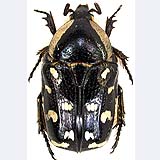 from Turkmenistan, photo D.Prunier |
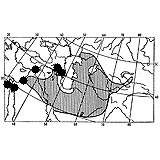 Distribution of Stalagmosoma albellum from Medvedev, modified |
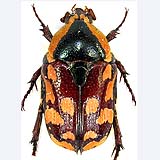 from Niger, Air, Arlit, leg. P.Tauzin photo D.Prunier |
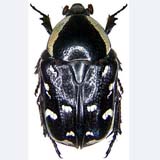 from Syria |
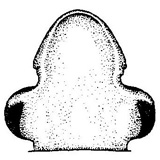 from Baraud |
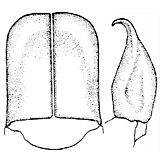 from Baraud |
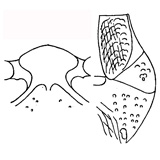 from Baraud |